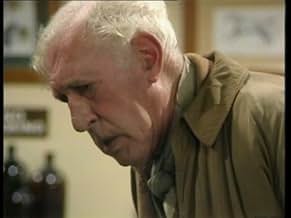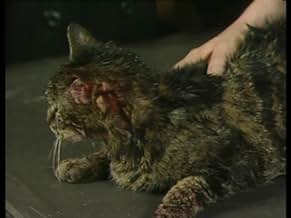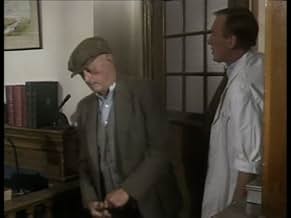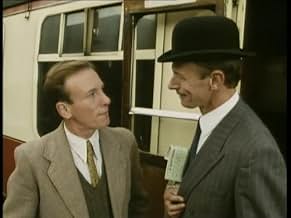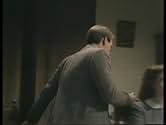1930 के दशक से 1950 के दशक तक यॉर्कशायर में एक देश के पशु चिकित्सा कार्यालय के कर्मचारियों के परीक्षण और दुस्साहस।1930 के दशक से 1950 के दशक तक यॉर्कशायर में एक देश के पशु चिकित्सा कार्यालय के कर्मचारियों के परीक्षण और दुस्साहस।1930 के दशक से 1950 के दशक तक यॉर्कशायर में एक देश के पशु चिकित्सा कार्यालय के कर्मचारियों के परीक्षण और दुस्साहस।
- 1 प्राइमटाइम एमी के लिए नामांकित
- 1 जीत और कुल 3 नामांकन
एपिसोड ब्राउज़ करें
फ़ीचर्ड समीक्षाएं
My first introduction to James Herriot was my father's laughing fits while reading the books. Then, the series appeared on PBS and I enjoyed what I saw, which in turn motivated me to read the books. The books are wonderful, almost in the realm of Fantasy (perhaps, the books are my second favorite set of books next to Lord of the Rings) if it weren't so grounded in reality. Sure Herriot smooths some of the rough edges off of his real life, but it still seems real. And this series captures the same feel that the books had, which no small achievement in my opinion. Most of the characters, major and minor, ring true to the depictions in the books and I have little trouble using the images when I re-read the books. Both the books and the series explore triumphs and failures that make life what it is. It makes common sense statements about life without being heavy handed about it. You almost feel you've lived the important, meaningful episodes of someone else's life as if they were your own. What more could be asked from auto-biographical (or semi-auto-biographical) material?
This television series is something special. It makes me laugh, brings a tear to my eye and puts a lump in my throat, often all in the same episode. It shows people, the main leads of James, Seigfried, and Tristan, (Helen too), as special, and who are lovable in their strength and eccentricities. This show is so special that I almost don't want to own it, whether on video or dvd. Why? Because possessing them might make them less special. I want to discover them again, be excited that they are on the PBS stations that I get, and feel blessed to visit with my old friends again.
Whenever I feel that I don't fit in this modern world, and that 'All Creatures Great and Small' was made for me alone, I know that I must have friends worldwide that I've never met, because we all love this show!
Whenever I feel that I don't fit in this modern world, and that 'All Creatures Great and Small' was made for me alone, I know that I must have friends worldwide that I've never met, because we all love this show!
10gooelf50
Such a fine series comes along only once or twice in a viewer's lifetime. The actors are second to none. Robert Hardy plays Siegfried Farnon in a wonderfully realistic manner. Here's a man who ranges from a soft natured rural country vetrinarian who cares passionately for every animal he treats, to a raving tyrant who rules his younger brother Tristan with an iron fist. His performances show acting ability that we seldom see in North American productions.
Christopher Timothy routinely delivers up fine performances as James Harriot, the younger partner in the vetrinary practice. Most of the episodes deal with his experiences and he manages to take somewhat mundane situations and make them exciting for the viewers. Over the life of the series we witness his evolution from an inexperienced young vetrinarian to a competent and practiced professional. Along the way we see him become a partner in the practice and woo and win Helen who eventually becomes his wife and the mother of his children.
Comic relief is always forthcoming from Tristan, played to perfection by Peter Davison. It's often hard to accept that he is Siegfreid's brother as the two men are absolute opposites; Siegfried being a serious, studious gentlemen with all the hallmarks of a finely bred British gentleman while Tristan is a boozing, carousing womanizer. The chemistry amongst these three actors makes the series one of the finest ever televised. The production itself is without equal. Scenes are shot on location with the actors participating directly in the action. It's not unusual to see Siegfried or James shoving their hands inside of a living beast to perform some medical process, or wallowing through a muddy barnyard.
A fine and highly realistic series on mid century vetrinarians; certainly the best I've ever seen.
Christopher Timothy routinely delivers up fine performances as James Harriot, the younger partner in the vetrinary practice. Most of the episodes deal with his experiences and he manages to take somewhat mundane situations and make them exciting for the viewers. Over the life of the series we witness his evolution from an inexperienced young vetrinarian to a competent and practiced professional. Along the way we see him become a partner in the practice and woo and win Helen who eventually becomes his wife and the mother of his children.
Comic relief is always forthcoming from Tristan, played to perfection by Peter Davison. It's often hard to accept that he is Siegfreid's brother as the two men are absolute opposites; Siegfried being a serious, studious gentlemen with all the hallmarks of a finely bred British gentleman while Tristan is a boozing, carousing womanizer. The chemistry amongst these three actors makes the series one of the finest ever televised. The production itself is without equal. Scenes are shot on location with the actors participating directly in the action. It's not unusual to see Siegfried or James shoving their hands inside of a living beast to perform some medical process, or wallowing through a muddy barnyard.
A fine and highly realistic series on mid century vetrinarians; certainly the best I've ever seen.
This film (and indeed series) is set in 1930's Britain, not the 1940's as stated elsewhere in this site, as Britain was involved in that fracas called the Second World War from 1939 and both Farnon and Herriot joined up with the Royal Air Force.... The books did carry on for the post war period but the film is firmly in the 30's! The attention to detail - even down to the advertisements by the roadside, is extraordinary, whilst the realisation of pre-war Britain, with its optimism, rugged individuality and, determination in sometimes very difficult circumstances is heartwarming. As a small piece of trivia, Christopher Timothy, who plays James Herriot has a limp in the later series, as he (for real) broke his leg during the filming of series two. Hardy, who played S. Farnon, is now even better known for his role as the Minister For Magic, in the Harry Potter films!
The original series of 41 episodes was a beautifully accurate version of the Herriott books. Superb acting is expected in a British production, and this is no exception, as the actors do an amazing job of capturing the essence of the even the minor characters. The vets, Christopher Timothy, Robert Hardy and Peter Davison are especially true, as is Carol Drinkwater (most superior to her replacement as Helen). The series also captures the essence of the Yorkshire Dales: the lovely green hillsides, wide vistas and individualistic spirit. Visiting that area is like stepping into the Herriott stories, as we discovered in 1982 and many subsequent visits. And having a pint with the cast between shooting on location showed us how authentic the series is. Many people don't realize that these are not `warm, fuzzy' animal stories. Each episode has a moral point to make and makes it subtly, through action not speeches. The series is also inspirational, for it is, implicitly, the story of the birth of scientific veterinary medicine.
क्या आपको पता है
- ट्रिवियाAlf Wight (the real James Herriot) initially stipulated that all the incidents in the TV series had to be closely based on those in his books. By the end of Season 3, all of Wight's books had been televised, and it was thought that the series would have to end. However producer Bill Sellars persuaded Wight to let the scriptwriters devise new stories as long as the scripts were approved by him and remained faithful to the spirit of his books.
- भाव
Mrs. Pumphrey: [orders Hodgekin to throw rings for her Pekinese, Tricki Woo. He throws one feebly] Oh, a little further than *that*, Hodgekin!
Mrs. Pumphrey: [he throws it miles] Not into the rose bed, Hodgekin! We wouldn't want Tricki to get pricky-paw!
Hodgekin: [muttered] Who wouldn't?
Mrs. Pumphrey: *What* was that? What was that, Hodgekin?
- कनेक्शनFeatured in Comic Relief: The Invasion of the Comic Tomatoes (1993)
टॉप पसंद
रेटिंग देने के लिए साइन-इन करें और वैयक्तिकृत सुझावों के लिए वॉचलिस्ट करें
- How many seasons does All Creatures Great & Small have?Alexa द्वारा संचालित
- Since Siegfried and Tristan are brothers . just who is "Mother"?
- Why was there a gap in the transmission of the first series?
विवरण
- रिलीज़ की तारीख़
- कंट्री ऑफ़ ओरिजिन
- भाषा
- इस रूप में भी जाना जाता है
- Der Doktor und das liebe Vieh
- फ़िल्माने की जगहें
- Langthwaite, Richmond, North Yorkshire, इंग्लैंड, यूनाइटेड किंगडम(hump-backed bridge which James and Siegfried drive over in opening titles of first two series)
- उत्पादन कंपनियां
- IMDbPro पर और कंपनी क्रेडिट देखें
इस पेज में योगदान दें
किसी बदलाव का सुझाव दें या अनुपलब्ध कॉन्टेंट जोड़ें

टॉप गैप
By what name was All Creatures Great & Small (1978) officially released in India in Hindi?
जवाब

